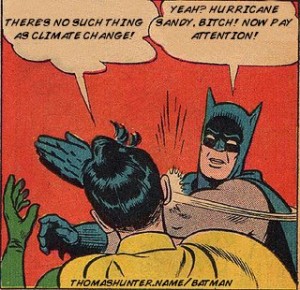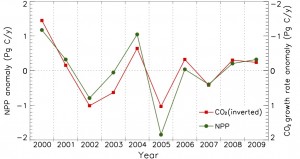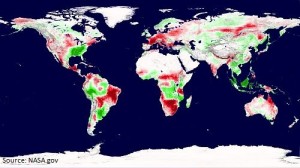Redirecting the Redirected: Returning Attention to Climate Change Policy and Planning
 Corporate interests with strong ties to conservative politics have undermined American’s awareness and understanding about climate change. Record profits from fossil fuel businesses have been threatened by talk of reducing consumption. Rather than change their business model, these entities went on the offensive against knowledge; facts were stretched until barely recognizable, bolstered with easy untruths, and fed to the public alongside infotainment through co-opted media.
Corporate interests with strong ties to conservative politics have undermined American’s awareness and understanding about climate change. Record profits from fossil fuel businesses have been threatened by talk of reducing consumption. Rather than change their business model, these entities went on the offensive against knowledge; facts were stretched until barely recognizable, bolstered with easy untruths, and fed to the public alongside infotainment through co-opted media.
The same fossil fuel interests bought politicians who are easily led by cash infusions or manipulated through electoral scaremongering by increasingly ignorant, easily acquired political factions (hello, Tea Party).
Presto: Americans are the least likely to believe in anthropomorphic climate change, and they’re likely to vote for candidates who mirror their own tractability.
But the truth has a nasty way of bitchslapping consumers and voters until their attention is returned to the facts. Hurricane Sandy, following this past summer’s wretched Dust Bowl-like drought, delivered a one-two punch to the public’s consciousness. Americans are ripe right-the-hell NOW for corrective action in the form of education and effective policy.
Therein lies the problem: there is no ongoing nationwide sustained discussion on climate change reaching a critical mass of the American public, and they in turn are not demanding better, effective, and immediate policy. There’s lots of hand-wringing over the damages caused by the drought and hurricane. There’s discussion about improvements to emergency response (tactical), and chatter about building dikes a la Netherlands to protect New York City from future hurricanes (tactical).
Yet there’s only tactical discussion–no society-wide dialog about strategic approaches to climate change.
The challenge to the educated and aware is to change this scenario and fast. The longer it takes for the tractable to become engaged and aware, the more time fossil fuel interests have to re-poison the minds of the public before the next truth-borne bitchslapping.
One of the key threats to this process is the stickiness of misinformation. (Ugh–let’s be frank, it’s the persistence of the stupid.) Fossil fuel’s misinfo takes two forms: deny anthropomorphic component to climate change, and corrupt understanding of climate cycles. These are not mutually exclusive, either.
The first is easy to rebut, however it takes clarity and simplicity scientists generally avoid, and media has ignored when produced.
Take a look at this chart:
 The relationship between plant productivity and CO2 is graphed here–note that the CO2 is inverse, though. Increased CO2 levels and subsequent related effects no longer improve plant output; it decreases it (read: decreased food outputs). Humans are the largest controllable variable when looking at global CO2 levels; we can make it or reduce it at will.
The relationship between plant productivity and CO2 is graphed here–note that the CO2 is inverse, though. Increased CO2 levels and subsequent related effects no longer improve plant output; it decreases it (read: decreased food outputs). Humans are the largest controllable variable when looking at global CO2 levels; we can make it or reduce it at will.
And then this chart — note, for example, the area on South American continent where rain forests are under attack.
 Red represents area with substantive plant growth & productivity declines; green represents increases in the same. Keep in mind that plant growth in sub-alpine, alpine, and desert areas will not offset losses of more dense plant growth in tropical, sub-tropical, and moderate areas.
Red represents area with substantive plant growth & productivity declines; green represents increases in the same. Keep in mind that plant growth in sub-alpine, alpine, and desert areas will not offset losses of more dense plant growth in tropical, sub-tropical, and moderate areas.
CO2, a by-product of fossil fuel combustion, now increases and decreases in tandem with plant growth. Humans control the amount of plants grown or harvested–period. We plant and harvest crops around the entire world, from edible commodities to lumber. If we plant less than we harvest (ex. rain forests cut down and replaced by a lesser amount of crops), it’s anticipated that CO2 level will reflect this change based on the current trend graphed above. (One might reasonably expect a similar shift in O2 levels as well, modifying the percentage of atmospheric CO2.) With adequate reversal of plant loss combined with reduction of anthropomorphic CO2 generation, CO2 to plant productivity may revert to a more positive relationship seen from 1982-1999.
This is simple evidence of man’s impact on the planet, and specifically on climate change-inducing greenhouse gas CO2.
Let’s now refer to past history, to address the issue of climate cycles. Talking heads and think tanks funded by fossil fuel and conservative interests often push back at anthropomorphic roots of climate change by pointing to climate cycles [PDF]. In short, they ignore climate change altogether because it’s natural. (Yeah, don’t worry about those potato chips. They’re all natural.)
But humans have seen the results of oh-so-natural climate change by cycle. In his book, Collapse: How Societies Choose to Fail or Succeed, Professor Jared Diamond looked at several societies that crashed, as well as possible causes:
Careful analysis of the frequency of droughts in the Maya area shows a tendency for them to recur at intervals of about 208 years. Those drought cycles may result from small variations in the sun’s radiation, possibly made more severe in the Maya area as a result of the rainfall gradient in the Yucatan (drier in the north, wetter in the south) shifting southwards. One might expect those changes in the sun’s radiation to affect not just the Maya region but, to varying degrees, the whole world. In fact, climatologists have noted that some other famous collapses of prehistoric civilizations far from the Maya realm appear to coincide with the peaks of those drought cycles, such as the collapse of the world’s first empire (the Akkadian Empire of Mesopotamia) around 2170 B.C., the collapse of the Moche IV civilization on the Peruvian coast around A.D. 600, and the collapse of the Tiwanaku civilization in the Andes around A.D. 1100.
Diamond’s suspicions about the Mayans’ collapse were recently validated. You’ll note the recent news about the Mayans’ societal collapse–climate change did them in. They abandoned their agrarian-centric way of life and moved to the beach after drought-driven downsizing and rapid de-urbanization.
(Unfortunately for us, it’s not certain if there will be a recognizable beach after the loss of polar ice and the subsequent rise of ocean levels. There certainly won’t be enough beach for all of us, either, assuming more folks will flee the drought-plagued heartland. And who will grow crops for us while we shift around on the beach for a new way of life?)
If Diamond was also correct that the Mayans’ collapse was tied to a cyclical climate change, why aren’t we talking about this cycle and what our response should be? This same 208-year cycle coincides with the de Vries-Suess solar cycle, implicated in other past climate change effects.
Do the math, it’s pretty simple.
| Moche IV collapse | ~600 A.D. |
| Classic Maya drought and collapse | ~600-800 A.D. |
| —– | |
| Tiwanaku collapse | ~1100 A.D. |
| —– | |
| Great Famine, Late Middle Ages, Europe | 1315-1317 A.D. |
| —– | |
| 30-year drought, Texas-Mexico | 1450-1489 A.D. |
| Spanish famine | 1504 A.D. |
| —– | |
| Worst documented drought, Texas-Mexico | 1697-1716 A.D. |
| Mongolian drought and intense volatility | 1723-1778 A.D. |
| —– | |
| Dust Bowl and drought | 1934-1940 A.D. |
Note these societal collapses and later major climate events occur in clusters at roughly 208-year cycles. There are other solar cycles [PDF] as well, each of which may result in climate change.
We can see these naturally occurring cycles. We can see the link between CO2 production and human activity. They are not mutually exclusive, and frankly, the former may greatly intensify the effects of the latter. How much of the Mayans’ collapse was due not only to drought, but poor resource management, overpopulation, and slow response to conditions that exacerbated the effects of drought?
At a minimum we should begin a national and global dialog about climate cycles and how we anticipate responding to their effects instead of allowing climate change denialists to use cycles as an excuse to avoid any discussion. Clearly even cycles represent catastrophic risks–we should not ignore them.
A far better approach would be a conversation conducted with a degree of urgency about climate change regardless of its natural or anthropomorphic causes. Sticking our heads in the sand will only result in drowning as hurricanes make landfall and ocean levels rise.
Let’s look at the math again: based on the 208-year de Vries-Suess cycle, the next peak should occur about 2130 A.D with conditions worsening for decades in advance as the peak approaches. If this past handful of years is any indication–and by my guess we are only half the way into the current de Vries-Suess cycle–2130 will be beyond ugly if we do not start our dialog now.
Moche-Mayan-Tiwanaku collapse ugly.